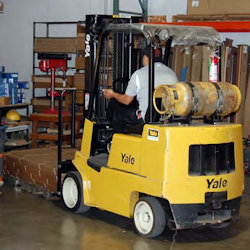Traveling
Precautions and best practices while traveling in a forklift include:

- The most basic rule for traveling is that you maintain control of your forklift at all times.
- Operate a forklift only while in the seat or operator's station.
- Never start it or operate the controls while standing beside the forklift.
- Never allow passengers unless the forklift was designed for a passenger.
- Do not put any part of your body between the uprights of the mast or when traveling, outside of the forklift frame.
- Never drive with wet or greasy hands. If necessary, keep a towel or rag handy at all times.
- Whether loaded or empty, carry forks and platforms on forklifts as low as possible. This lowers the center of gravity and reduces the possibility of overturning the forklift or dumping the load.
- Always look in the direction of travel and keep a clear view of the travel path. Travel in reverse if the load blocks your view.
- Always observe posted speed limits (usually 5 mph) at your workplace. A forklift should not be driven faster than a quick walking pace.
- Keep a distance of at least three forklift lengths between you and any forklift traveling in front of you.
- Do not pass a forklift traveling in the same direction if it is at a blind spot, intersection or other dangerous location.
- Never drive a forklift up to anyone in front of a bench or other fixed object.
- Never allow anyone to walk or stand under the elevated forks - even if the forks are not carrying a load.
- Check that there is adequate clearance under beams, lights, sprinklers, and pipes for the forklift and load to pass.
- Never engage in stunt driving or horseplay.
Failure to Wear Seatbelt Causes Fatal Forklift Accident
An August 29, 2023 fatality may have been prevented if the employer had ensured proper operation of forklifts. An Airport Technical Services’ employee was attempting to drive a forklift into a building when the vehicle’s forks and mast struck the overhang of the entrance, causing the forklift to tip over. The operator, who was not wearing a seatbelt, fell to the ground, and the tipping forklift fatally struck him.
OSHA inspectors found that the company failed to ensure the worker wore a seat belt while operating the forklift, exposing him to rollover and crushing hazards. The agency also determined the following:
- The forklift’s forks and mast were not raised only as far as necessary to clear the road surface.
- All forklift operators were not properly trained and certified.
- A damaged forklift was not examined before being placed in service.
- A damaged forklift was not taken out of service.
Knowledge Check Choose the best answer for the question.
4-3. The most basic rule for traveling in a forklift is that you _____.
You forgot to answer the question!
